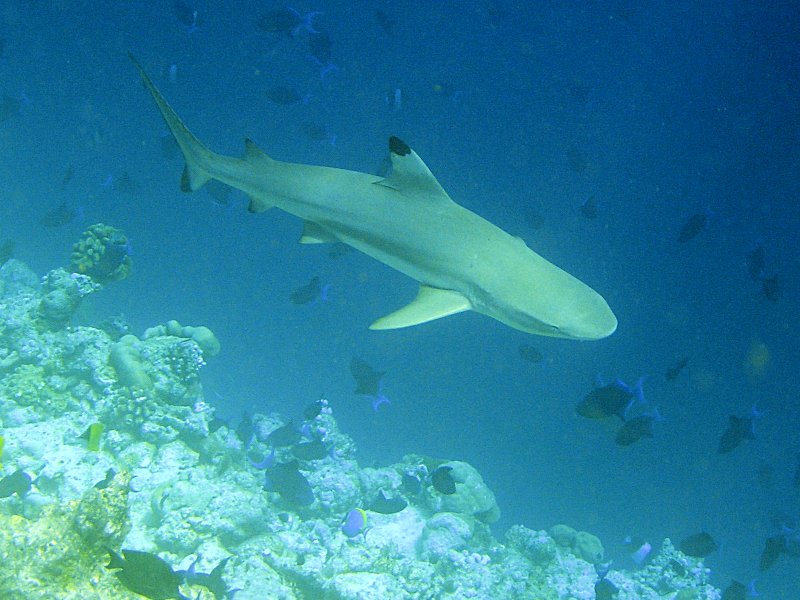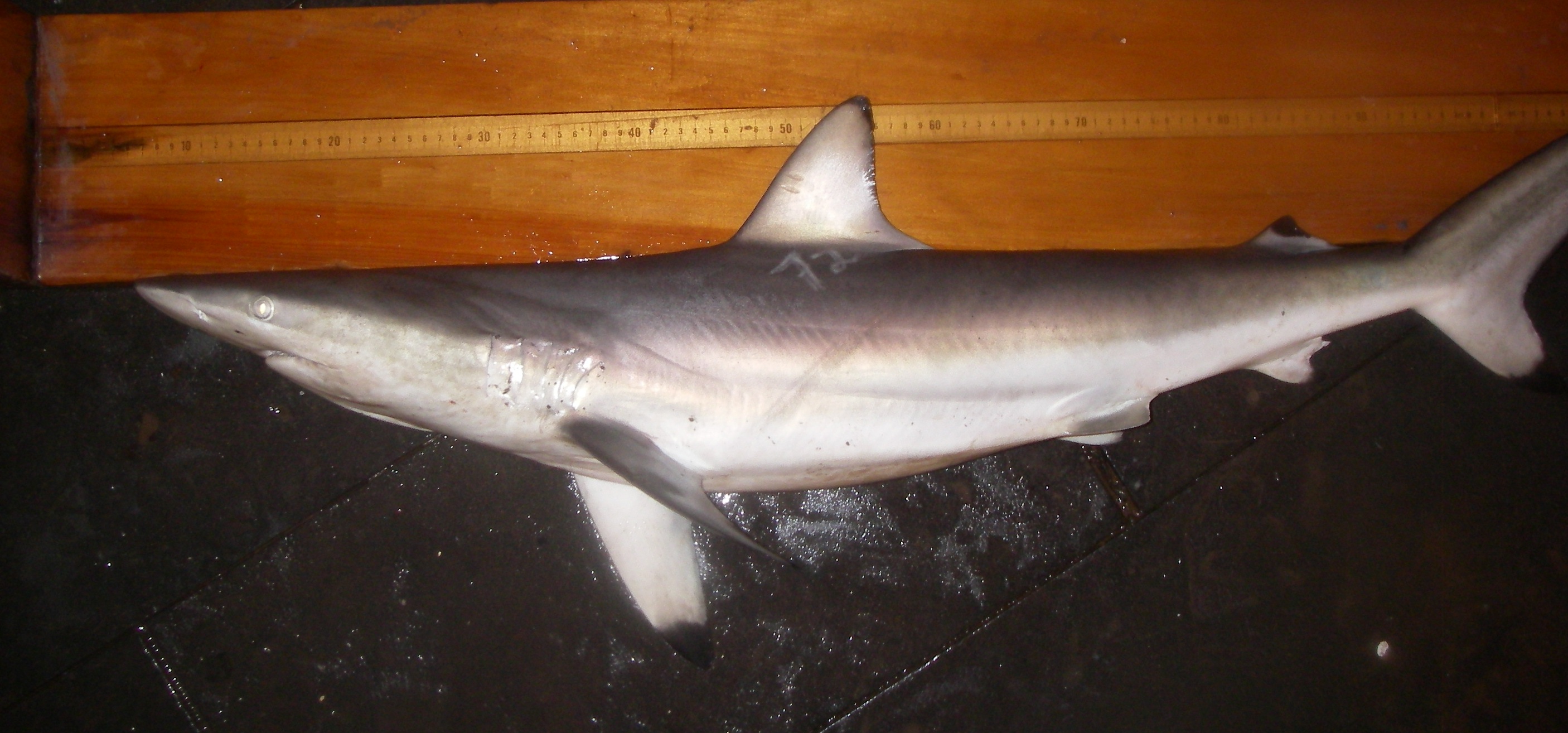|
Isogomphodon
The daggernose shark (''Isogomphodon oxyrhynchus'') is a little-known species of requiem shark, in the family Carcharhinidae, and the only extant member of its genus. It inhabits shallow tropical waters off northeastern South America, from Trinidad to northern Brazil, favoring muddy habitats such as mangroves, estuaries, and river mouths, though it is intolerant of fresh water. A relatively small shark typically reaching in length, the daggernose shark is unmistakable for its elongated, flattened, and pointed snout, tiny eyes, and large paddle-shaped pectoral fins. Daggernose sharks are predators of small schooling fishes. Its reproduction is viviparous, with females give birth to 2–8 pups every other year during the rainy season; this species is capable of shifting the timing of its reproductive cycle by several months in response to the environment. Harmless to humans, the daggernose shark is caught for food and as bycatch in artisanal and commercial fisheries. Limited in r ... [...More Info...] [...Related Items...] OR: [Wikipedia] [Google] [Baidu] |
Requiem Shark
Requiem sharks are sharks of the family Carcharhinidae in the order Carcharhiniformes. They are migratory, live-bearing sharks of warm seas (sometimes of brackish or fresh water) and include such species as the tiger shark, bull shark, lemon shark, spinner shark, blacknose shark, blacktip shark, grey reef shark, blacktip reef shark, silky shark, dusky shark, blue shark, copper shark, oceanic whitetip shark, and whitetip reef shark. Family members have the usual carcharhiniform characteristics. Their eyes are round, and one or two gill slits fall over the pectoral fin base. Most species are viviparous, the young being born fully developed. They vary widely in size, from as small as adult length in the Australian sharpnose shark, up to adult length in the tiger shark.Compagno, L.J.VFamily Carcharhinidae - Requiem sharksin Froese, R. and D. Pauly. Editors. 2010FishBase World Wide Web electronic publication, version (10/2013). Scientists assume that size and shape of thei ... [...More Info...] [...Related Items...] OR: [Wikipedia] [Google] [Baidu] |
Requiem Shark
Requiem sharks are sharks of the family Carcharhinidae in the order Carcharhiniformes. They are migratory, live-bearing sharks of warm seas (sometimes of brackish or fresh water) and include such species as the tiger shark, bull shark, lemon shark, spinner shark, blacknose shark, blacktip shark, grey reef shark, blacktip reef shark, silky shark, dusky shark, blue shark, copper shark, oceanic whitetip shark, and whitetip reef shark. Family members have the usual carcharhiniform characteristics. Their eyes are round, and one or two gill slits fall over the pectoral fin base. Most species are viviparous, the young being born fully developed. They vary widely in size, from as small as adult length in the Australian sharpnose shark, up to adult length in the tiger shark.Compagno, L.J.VFamily Carcharhinidae - Requiem sharksin Froese, R. and D. Pauly. Editors. 2010FishBase World Wide Web electronic publication, version (10/2013). Scientists assume that size and shape of thei ... [...More Info...] [...Related Items...] OR: [Wikipedia] [Google] [Baidu] |
Theodore Gill
Theodore Nicholas Gill (March 21, 1837 – September 25, 1914) was an American ichthyologist, mammalogist, malacologist and librarian. Career Born and educated in New York City under private tutors, Gill early showed interest in natural history. He was associated with J. Carson Brevoort in the arrangement of the latter's entomological and ichthyological collections before going to Washington D.C. in 1863 to work at the Smithsonian Institution. He catalogued mammals, fishes and mollusks most particularly although maintaining proficiency in other orders of animals. He was librarian at the Smithsonian and also senior assistant to the Library of Congress. He was elected as a member of the American Philosophical Society in 1867. Gill was professor of zoology at George Washington University. He was also a member of the Megatherium Club at the Smithsonian Institution in Washington, D.C. Fellow members frequently mocked him for his vanity. He was president of the American Associati ... [...More Info...] [...Related Items...] OR: [Wikipedia] [Google] [Baidu] |
Viviparous
Among animals, viviparity is development of the embryo inside the body of the parent. This is opposed to oviparity which is a reproductive mode in which females lay developing eggs that complete their development and hatch externally from the mother. The term 'viviparity' and its adjective form 'viviparous' derive from the Latin ''vivus'' meaning "living" and ''pario'' meaning "give birth to". Reproductive mode Five modes of reproduction have been differentiated in animals based on relations between zygote and parents. The five include two nonviviparous modes: ovuliparity, with external fertilisation, and oviparity, with internal fertilisation. In the latter, the female lays zygotes as eggs with a large yolk; this occurs in all birds, most reptiles, and some fishes. These modes are distinguished from viviparity, which covers all the modes that result in live birth: *Histotrophic viviparity: the zygotes develop in the female's oviducts, but find their nutrients by oophagy ... [...More Info...] [...Related Items...] OR: [Wikipedia] [Google] [Baidu] |
Stewart Springer
Stewart Springer (5 June 190623 August 1991) was an American ichthyologist and herpetologist. He was a world-renowned expert on shark behavior, classification (taxonomy), and population distribution. More than 35 species of sharks, skates, rays, and other creatures are either classified by or named after him. Education Springer was a field naturalist, mostly self-taught. In 1964, 35 years after he dropped out of Butler University, Springer obtained a baccalaureate from George Washington University after having already achieved success in his chosen field of ichthyology. Many colleagues and students addressed him as Dr. on the mistaken assumption that he must have a Ph.D. in biology or an allied field given his status in the world community of ichthyologists. His exceptional interest in animal behavior was apparent early in his life, when at age 22, he identified and described a new species of lizard, '' Cnemidophorus velox'', the plateau striped whiptail. His interest in the wh ... [...More Info...] [...Related Items...] OR: [Wikipedia] [Google] [Baidu] |
Carcharhinus
''Carcharhinus'' is the type genus of the family Carcharhinidae, the requiem sharks. One of 12 genera in its family, it contains over half of the species therein. It contains 35 extant and eight extinct species to date, with likely more species yet to be described. Species Extant T Type species Fossil See also * List of prehistoric cartilaginous fish genera This list of prehistoric cartilaginous fish genera is an attempt to create a comprehensive listing of all genera that have ever been included in the class chondrichthyes ''and'' are known from the fossil record. This list excludes purely vernacul ... References Bibliography * * * * * * * {{Taxonbar, from=Q312359 Shark genera Extant Eocene first appearances Taxa named by Henri Marie Ducrotay de Blainville ... [...More Info...] [...Related Items...] OR: [Wikipedia] [Google] [Baidu] |
Synonym (taxonomy)
The Botanical and Zoological Codes of nomenclature treat the concept of synonymy differently. * In botanical nomenclature, a synonym is a scientific name that applies to a taxon that (now) goes by a different scientific name. For example, Linnaeus was the first to give a scientific name (under the currently used system of scientific nomenclature) to the Norway spruce, which he called ''Pinus abies''. This name is no longer in use, so it is now a synonym of the current scientific name, ''Picea abies''. * In zoology, moving a species from one genus to another results in a different binomen, but the name is considered an alternative combination rather than a synonym. The concept of synonymy in zoology is reserved for two names at the same rank that refers to a taxon at that rank - for example, the name ''Papilio prorsa'' Linnaeus, 1758 is a junior synonym of ''Papilio levana'' Linnaeus, 1758, being names for different seasonal forms of the species now referred to as ''Araschnia le ... [...More Info...] [...Related Items...] OR: [Wikipedia] [Google] [Baidu] |
Ichthyologist
Ichthyology is the branch of zoology devoted to the study of fish, including bony fish ( Osteichthyes), cartilaginous fish (Chondrichthyes), and jawless fish (Agnatha). According to FishBase, 33,400 species of fish had been described as of October 2016, with approximately 250 new species described each year. Etymology The word is derived from the Greek words ἰχθύς, ''ikhthus'', meaning "fish"; and λογία, ''logia'', meaning "to study". History The study of fish dates from the Upper Paleolithic Revolution (with the advent of "high culture"). The science of ichthyology was developed in several interconnecting epochs, each with various significant advancements. The study of fish receives its origins from humans' desire to feed, clothe, and equip themselves with useful implements. According to Michael Barton, a prominent ichthyologist and professor at Centre College, "the earliest ichthyologists were ''hunters and gatherers'' who had learned how to obtain the most usef ... [...More Info...] [...Related Items...] OR: [Wikipedia] [Google] [Baidu] |
Specific Name (zoology)
In zoological nomenclature, the specific name (also specific epithet or species epithet) is the second part (the second name) within the scientific name of a species (a binomen). The first part of the name of a species is the name of the genus or the generic name. The rules and regulations governing the giving of a new species name are explained in the article species description. For example, the scientific name for humans is ''Homo sapiens'', which is the species name, consisting of two names: ''Homo'' is the " generic name" (the name of the genus) and ''sapiens'' is the "specific name". Historically, ''specific name'' referred to the combination of what are now called the generic and specific names. Carl Linnaeus, who formalized binomial nomenclature, made explicit distinctions between specific, generic, and trivial names. The generic name was that of the genus, the first in the binomial, the trivial name was the second name in the binomial, and the specific the proper term for ... [...More Info...] [...Related Items...] OR: [Wikipedia] [Google] [Baidu] |
Carcharias Oxyrhynchus By Muller And Henle
''Carcharias'' is a genus of sand tiger sharks belonging to the family Odontaspididae. Once bearing many prehistoric species, all have gone extinct with the exception of the critically endangered sand tiger shark. Description ''Carcharias'' are 2.5 m long on average. The maximum weight of the shark is 158.8 kg. Differentiating species of sharks is usually done by locating and measuring their fins. The second dorsal fin and the anal fin of ''Carcharias'' are very large. In fact, they are about equal in size. The pectoral fins are triangular and only slightly larger than the dorsal fins. The teeth are very long and narrow with sharp points. The teeth are smooth with no ridges. The tail is one third of the entire body size. Diet ''Carcharias'' species hunt bony fish, small sharks, rays, squids, crabs, and lobsters. Habitat Sand tiger sharks live in water depths ranging from 0 to 190 meters. They are found in the Pacific, Atlantic, and Indian oceans. They are commonl ... [...More Info...] [...Related Items...] OR: [Wikipedia] [Google] [Baidu] |
International Union For Conservation Of Nature
The International Union for Conservation of Nature (IUCN; officially International Union for Conservation of Nature and Natural Resources) is an international organization working in the field of nature conservation and sustainable use of natural resources. It is involved in data gathering and analysis, research, field projects, advocacy, and education. IUCN's mission is to "influence, encourage and assist societies throughout the world to conserve nature and to ensure that any use of natural resources is equitable and ecologically sustainable". Over the past decades, IUCN has widened its focus beyond conservation ecology and now incorporates issues related to sustainable development in its projects. IUCN does not itself aim to mobilize the public in support of nature conservation. It tries to influence the actions of governments, business and other stakeholders by providing information and advice and through building partnerships. The organization is best known to the wider pu ... [...More Info...] [...Related Items...] OR: [Wikipedia] [Google] [Baidu] |








